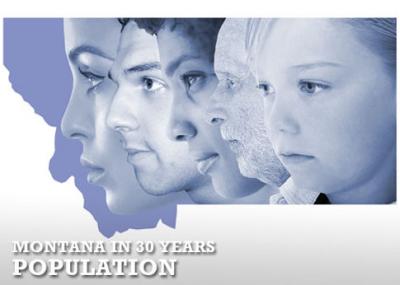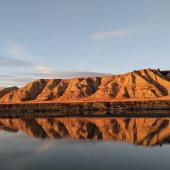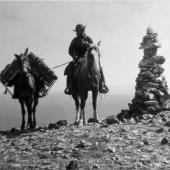Montana in 30 Years: Population
Interview with Patrick M. Barkey
Director of the Bureau of Business and Economic Research at the University of Montana
What is Montana’s projected population for 2044?
Our projection is that Montana’s population in year 2044 will be 1,222,000 people, which compares to a count of 989,414 as determined by the 2010 census. This is a slower rate of population growth than occurred during the last decade 2000-2010. In that 10-year period, Montana added 87,220 net new residents, a 9.7 percent increase (0.93 percent per year). This was exactly equal to the percent growth in the national population, but it was the slowest population growth of any other state in the Western Census region. Our forecast for population calls for growth in the coming years at roughly half that rate.

What portion of population increase in Montana is from birth rates and from in-migration?
The so-called natural rate of growth in population, defined as births minus deaths, has contributed to population growth each year as life expectancies grow. Currently the natural growth in Montana’s population is on the order of 3,100 people per year. As life expectancy increases tail off, however, and as the oldest cohorts of Montana’s population become relatively more prominent, this natural increase diminishes. We estimate by year 2044 it will be essentially zero.
Migration rates, on the other hand, are more volatile. In the 1980’s in Montana they were negative. They also shrank considerably during the recent recession.
We expect to see them stabilize around 6,500 people per year at this decade’s mid-point, with fluctuations around that order of magnitude in each of the coming years.
All of these forecasts are for the state as a whole. Regions and individual counties within Montana can have quite different demographic patterns.
Which states contribute the most in-migration affecting Montana’s population growth? Will this change over time?
The two major statistical determinants of migration are population and distance. This translates into two principals: 1) the greater the population of two states, the greater the migration between them; 2) the less the distance between two states, the greater the migration.
The Census Bureau reports that Washington State provided the most in-migrants (4,783) to Montana during 2012, while Idaho was second at 3.385. The Washington figure can be attributed to its large population of 6,815,800. Idaho’s population was only 1,573,000 but is adjacent to Montana. Last decade California was a significant contributor of new residents, particularly to Ravalli, Flathead, and Gallatin counties. In-migration in the last decade was primarily to Western Montana. The last couple of years Eastern Montana counties have been getting the bulk of in-migrants.
What prospects are there for a new era of “homesteading” by immigrant peoples?
I think this is unlikely. The homesteading during the early 1900’s was the result of land being available and sizable foreign migration. A lot of things would have to change simply to make this process legally feasible, let alone economically viable.
Montana is one of the least densely populated states in the nation. Are there any real problems facing the state from population growth through 2044?
The issues are certainly localized. In western valleys with less developable land and/or with issues with aquifers or other resources, strong local population growth could pose issues. But for many parts of the state a lack of population growth — or more specifically, the out migration of younger residents — presents the more acute problems for infrastructure, schools, and overall viability of smaller communities.
Population growth seems concentrated in a handful of counties statewide with a bias for “urban” counties. What could influence greater geographic diversity for an increasing population?
By far the dominant factor for county population growth rates is economic opportunity. Younger, more mobile people are attracted by higher wages and work opportunities. A second migration dynamic is less pronounced but more important for rural areas. That is amenity-based migration of middle-aged people for quality of life. Often the counties that can benefit from this are those which are adjacent to urban areas, so Montana’s “frontier” counties do not fully participate.
Energy development is an example of an economic opportunity that has actually drawn people away from urban areas, since for the fossil fuel-related development that is where the resources are. This has been affecting communities such as Glendive and Miles City, which were stagnating before the boom occurred. These trends make population forecasting so “interesting.”
What does the population age demographic look like for 30 years from now? What about ethnicity?
Over 30 years, the age composition in Montana changes considerably, although the growth in the oldest age cohorts does not go on indefinitely. About 22 percent of Montanans in year 2044 will be 65 years of age or older, compared to 17 percent today. 5.3 percent of Montanans 30 years from now will be 85 years of age or older, much higher than the 2.2 percent in that age cohort today. Clearly that has big implications for social services, housing, health care, and even state tax receipts. Higher birth rates among American Indians does slightly raise their share of the total population, whereas black and Hispanic populations are expected to remain small.
Do you think that the impacts of climate change will skew the population projections you are looking at today?
Climate change is one of many trends that could torpedo these predictions, certainly. We tried to speculate on how climate change could affect the Montana economy a few years ago in a Montana Business Quarterly article (Summer 2007). Even if climate change was certain, its impacts on Montana are far from predictable. Regardless, it has the potential to make Montana a more attractive state to live and do business and so could be important.
Have we missed any important trends for population increase in Montana?
I would simply say that states are political, not economic constructs. So demographic patterns are quite different between different parts of our state, just as the economic base varies. When state government is concerned, we are all one state. But in terms of our economic and ultimately our population dynamics over a long time span, different parts of the state may follow their own script. The potential for, say, a Bozeman to become the size of Boise in 30 years cannot be totally discounted, but it would certainly be really tough right now to make that call. Long-term population projections can be fraught with error, particularly when assumptions about rates of in-migration, birth rates, and life expectancies are not borne out.












Leave a Comment Here